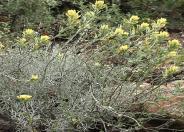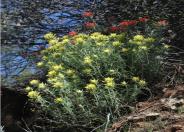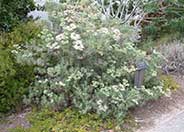
Common name:California Buckwheat
Botanical name:Eriogonum fasciculatum
Eriogonum fasciculatum is fast growing woody perennial with tiny narrow leaves and pink-white flower heads that dry to a rust color.

Common name:Island White-Felted Paintbrush
Botanical name:Castilleja hololeuca
Island white-felted paintbrush is a California native perennial herb that has thick woody roots with erect stems that are very branching. Leaves are gray. Yellow flowers appear in March and can last through August, appearing at the top of foliage. It can quickly reach 2-3 ft tall and wide. It prefers full sun and is not particular about soil requirements. Butterflies and moths are attracted to this plant.

Common name:Indian Paintbrush
Botanical name:Castilleja affinis
Indian Paintbrush is a species native to western North America from Washington to Baja California, where it grows on hills and mountains slopes along the coast and inland. This is a perennial herb growing an erect stem up to 2' in maximum height. It is greenish to purple in color and may be hairless to quite hairy. The leaves are variable in shape and up to 3" long. The flower cluster is a series of leaves in shades of bright red to yellowish. The fruit is a capsule less than half inch long. Ssp. affinis (Coast Indian paintbrush) occurs commonly throughout western North America from Washington to Baja California. Castilleja is a hemi-parasite, meaning that it derives some of its nutrients from a host plant. It does best in full sun with rocky and sandy soil. It does well in coastal areas and is used for butterfly gardens.

Common name:Santa Cruz Island Buckwheat, Wild B
Botanical name:Eriogonum arborescens
Santa Cruz Island Buckwheat is a loosely branched shrub growing 2-5 ft. high and wide with shredding gray to reddish bark, grayish foliage, and creamy pink spring flowers. It is a California Native, drought tolerant, attracts butterflies and beneficial insects. - Cornflower Farms.
Designer:
Photographer: Vicki Anderson
Incorporate compost 6" into your soil to retain water, reduce compaction, feed earthworms, and provide valuable nutrients to your plants.
Remove irrigation water and fertilizer from areas where you don't want weeds to grow.